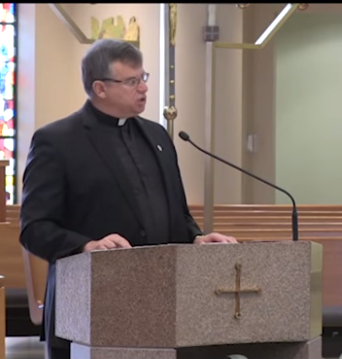 “A Week of Sundays” Considering Consecrated Life
“A Week of Sundays” Considering Consecrated Life
During this year of consecrated life, two familiar elements of Easter have drawn my particular attention.
One happens at the vigil itself…. The second element stems from the prayers used during the octave of Easter… No one day can capture the grandeur of this, the greatest of Christian feasts, and so the exultation demands an additional full week of solemnities to complement the force of the “Mother of all Vigils”
The full text…
One happens at the vigil itself. When the minister carries the Easter candle into the Church, he declares “Christ, our Light.” The intent is to proclaim those words at the same places in the building where, two days before, the cross was carried about with the proclamation “Behold the wood of the cross on which hung the Savior of the world.” The association of place uniting the two symbols of the cross and the candle is striking. In many ways, the cross represents the low point of humankind’s darkest hour. It holds out the moment when mortal sinfulness—our willful turning away from the love of God—exacts its greatest toll. On the other hand, the candle powerfully represents the effects of the sacrifice and resurrection of Jesus. The darkness is dispelled by the brightness of the light. As the candle pierces the blackness, grace overcomes sin, and life conquers death.
Considering consecrated life in this context proves fruitful. For those who commit themselves to this special form of life, the aptness of the image must shine forth. Pope Benedict encourages us:
“Dear brothers and sisters, in the finest traditions of the Church in this country [USA], may you also be the first friend of the poor, the homeless, the stranger, the sick and all who suffer. Act as beacons of hope, casting the light of Christ upon the world. . . .” (Benedict XVI, 19April08)
Within the Vincentian Family, this directive could be heard as aimed at us in a special way. The message finds ready application for our charism. Those darkest places, where the Gospel cries out to be seen and heard, among those who are poorest and most abandoned, need to attract us. The weight of the cross falls more heavily upon the shoulders of those who look to us for assistance. We must allow our light to shine in that world more abundantly.
The second element stems from the prayers used during the octave of Easter. These supplications consistently speak about the happenings “on this Easter Day.” The celebration of the Lord’s Resurrection holds such a prominent place in the heart of the Church that its remembrance extends for seven consecutive days after the First Sunday! The community prays the Gloria and proclaims the Easter alleluia which will afterwards remain unsung until Pentecost. No one day can capture the grandeur of this, the greatest of Christian feasts, and so the exultation demands an additional full week of solemnities to complement the force of the “Mother of all Vigils” (General Norms, No. 21) with which it began.
Paul would understand this emphasis. His reflections on the Resurrection express his usual gift for description and drama:
“But now Christ has been raised from the dead, the firstfruits of those who have fallen asleep.” (1 Cor 15:20)
“He is the beginning, the firstborn from the dead, . . .” (Col 1:18)
“So whoever is in Christ is a new creation: the old things have passed away; behold, new things have come.” (2 Cor 5:17)
The beginning of an original and authentic life provides the foundational concept for the meaning of the Resurrection. No single day’s celebration could be sufficient. Like the new wine, it bursts all attempts at constraint.
In this Year of Consecrated Live, the extended Easter celebration can remind us that we dedicate to the Lord that very life which we have received as gift. We have nothing more precious to bring to the altar than the offering of that sustaining breath with which the Holy One has filled our lungs. We bring the same alms to our Lords and Masters. Remember how St. Vincent speaks of St. Lazare as a place of new life:
This house, Messieurs, was formerly a refuge for lepers; they were welcomed in it, and not one of them was cured. Now it’s used to welcome sinners, sick persons covered with spiritual leprosy, but who are cured by the grace of God. Or rather, let’s say that they’re dead persons who have come back to life. What happiness that the Saint-Lazare house should be a place of resurrection! (VdP, CCD 11, L.9, p. 13)
We can extend that imagery to embrace not simply sinners but those who are poor. What a blessing when our communities and ministries give life to those who know the impoverishment of death most closely.
Light and life. These Easter staples nourish the Vincentian heart and set the tone for the fidelity of a consecrated person.





0 Comments